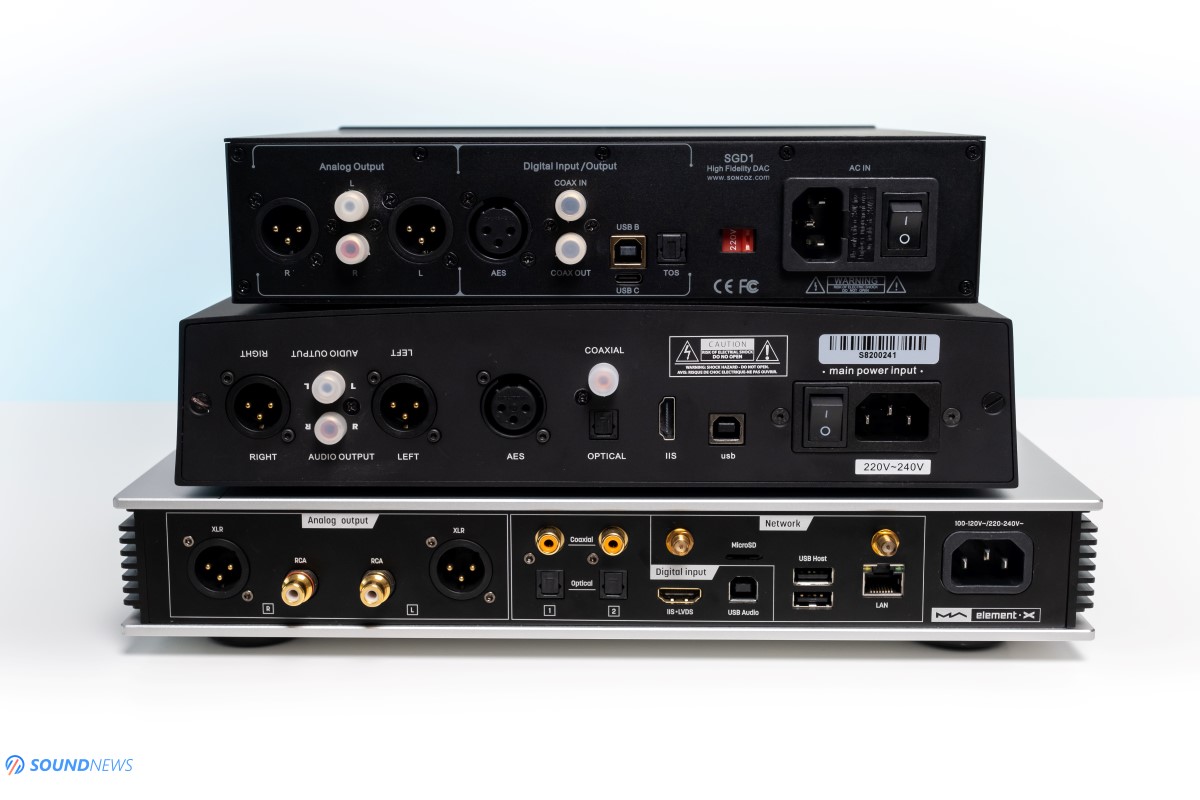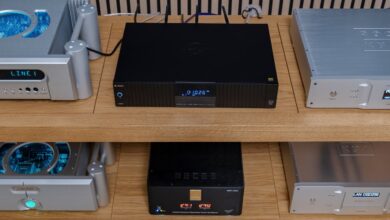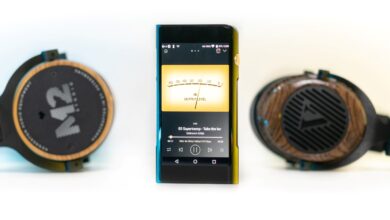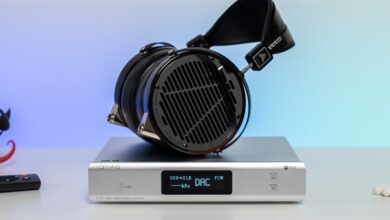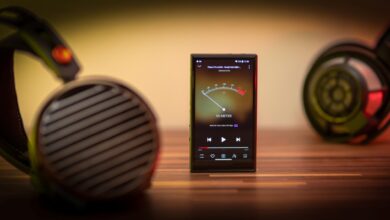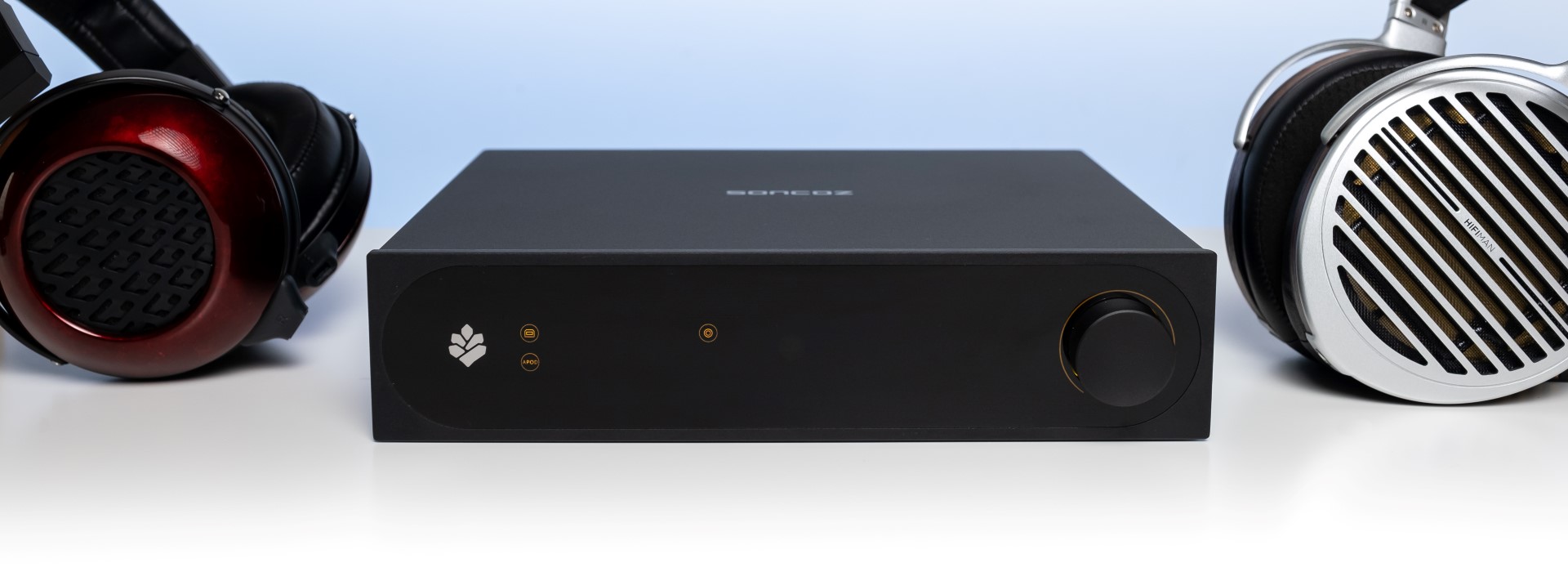
My Video Review:
About a month ago I’ve tested an affordable true-balanced ESS-Sabre DAC that also happened to be the best sounding entry-level unit I ever stumbled upon. Soncoz LA-QXD1 simply ticked all the boxes for me, it sounded marvelously close to mid-range DACs that I’ve felt the urge to honor it with our Bronze Award for getting everything right, including its price.
It shouldn’t be surprised to anyone, considering that the mastermind behind it is no other than Ben Du that created those super affordable and immensely popular Khadas Tone boards. Khadas was created to offer you the best bang for the buck, I’m sure that Tone 1 sounds incredibly good for its size and price, but I’m also sure that a well-designed desktop DAC that is not limited by internal space, power consumption and budget will simply outperform it in all key aspects, including measurements. That is precisely why Soncoz Audio was created – it’s a fresh ‘n young team and you can learn more about them on their website right here. According to them, their mission is to design only the very best audio products that can achieve balanced, full range and bit perfect reproduction of every note, frequency and detail of your music.
With this fresh new company, Ben and his men would have a total freedom to unleash their geniuses, without any kind of space or budged limitations. Their first such device is of course a normal sized unit called SGD1 DAC/Preamp/Bluetooth receiver/digital to coaxial interface that I will be testing today. SGD1 is currently their second product and for now it’s their top-of-the-line unit. I’m genuinely super excited to be making an objective and comprehensive review in a headphone and speaker-based setup, so let’s get it started.
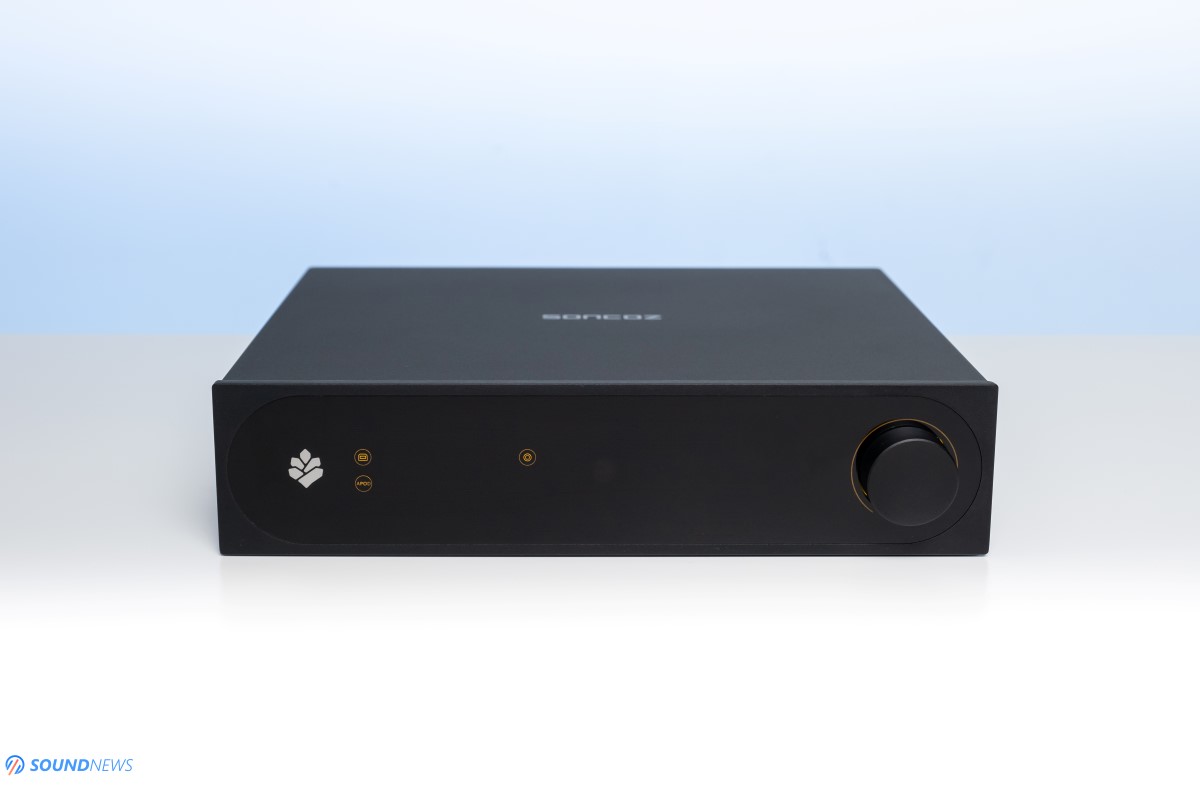
Unboxing & Package Contents
SGD1 came in an extra-large box suggesting that there is an XL sized unit lurking somewhere inside. SGD1 came well-protected with a huge amount of bubble foam wrapping the entire unit. SGD1 looked considerably bigger and heavier compared to units of the same price. An accessory compartment will be holding a power cable, a high-quality golden-plated USB Type-B cable and a matte-black remote control with Soncoz branding on it – suggesting that it can also work as a preamp. I didn’t find a user manual inside or any other papers, but don’t you worry as you can download its USB driver and manuals from their downloads section right here.
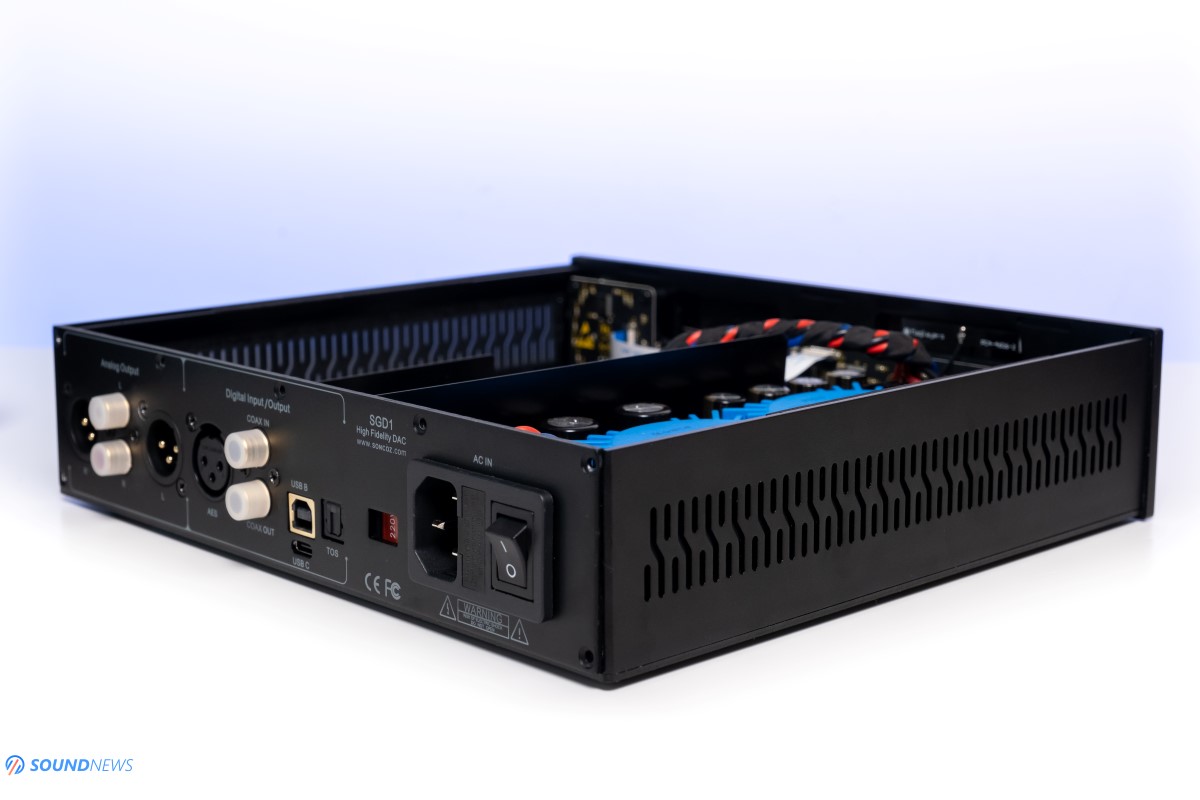
Design & Build Quality
I have to say that SGD1 looks and feels exactly as premium as any top-of-the-line DAC. There are several things which I didn’t expect, nor seen in other DACs. For example, the volume knob has an LED strip around it and only by looking at its light it should be clear where is your volume position. When it’s fully lit, you will be unleashing its full signal power of 4V over XLR and 2V over PCM, it looks cool and quite unique actually. I’ve never seen such a clever and extremely easy to use user interface. There is an LCD screen in the middle and it will show you only the selected digital input, that Coaxial out is engaged and your digital filter, nothing more and nothing less. No more complicated user menus (I’m looking at you Audio-GD), not more hidden user menus that can only be accessed from the remote (I’m looking at you Topping and SMSL). Just a simple, elegant solution that works and it’s extremely easy to use. I don’t know who designed this simple yet effective user interface or its casing, but so far, I’m impressed. You can control every feature of it by using its volume knob or the included remote and it is really up to you.
Soncoz put some ventilation holes under the unit and on its side panels, so that hot air would move away from the unit. Instead of letting that an open area, where dust particles could enter freely as it happens on my Matrix Audio Element X, they added a dust filter to prevent that – pretty clever.
The only thing that I dislike about it are those short feet under the unit, I would put longer ones (at least 4 times their actual depth). I’m usually placing a heavy desktop headphone amp on top of my DACs in my office and with Benchmark HPA4 on top of it, SGD1 is almost touching the table, completely blocking the air intake.
As for its case, it is an aluminum one milled on a CNC machine, with very tight tolerance numbers. All the screws were moved on the back panel for a clean and elegant look. The front panel has a sheet of glass with a Soncoz logo under it, they seem to care about its looks and build-quality and that can be immediately felt after closely inspecting their unit. Soncoz is offering it in two color options: matte-black (our review unit) or matte-gray – which aren’t attracting a lot of eyes to them. SGD1 has a simple metal brick-like design and I’m fine with that, as most of the Hi-Fi gear is looking this way.
At about 3 kg or 6.6 pounds, SGD1 is on the heavier side and it gives an impression of a well-engineered and well-made product. From all DAC manufacturers coming from Asia I have tested of late, Soncoz has definitely one of the best looks and form factor.
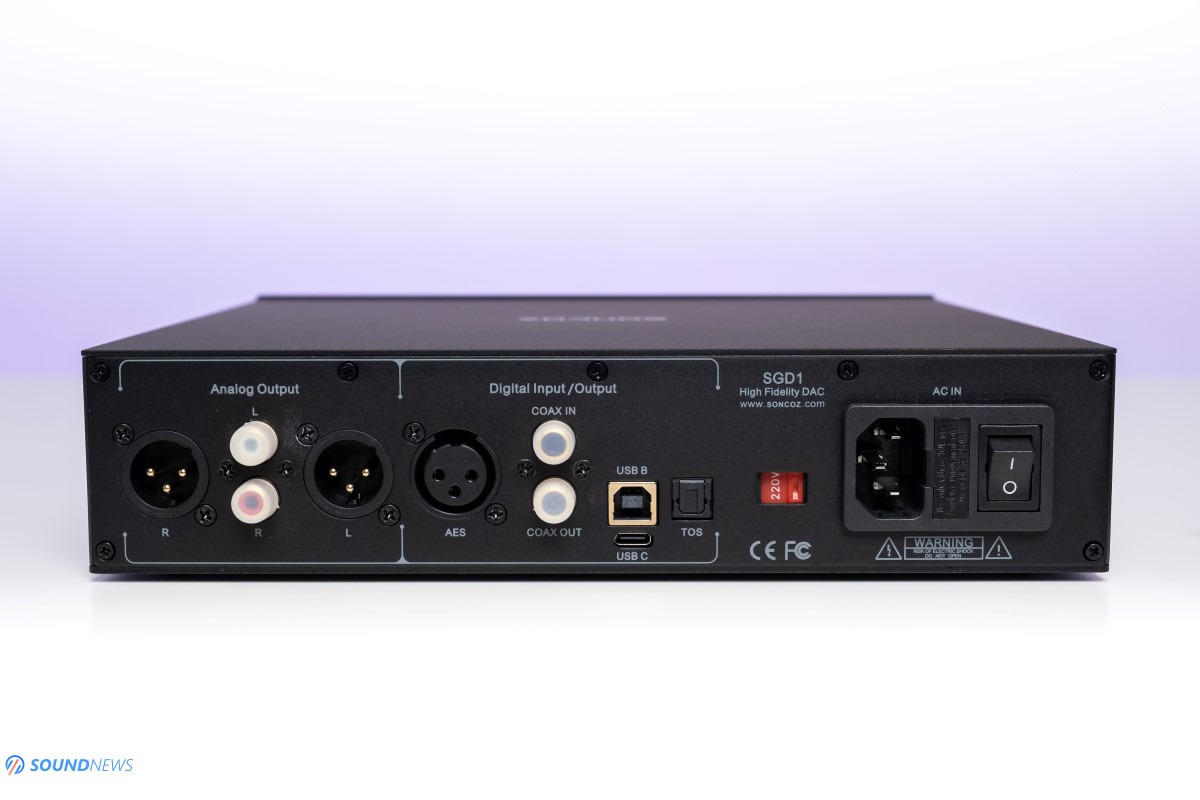
Controls & I/O
SGD1 has a clean looking front panel, with just a volume knob on the right and a sheet of glass exactly in the middle that house its LCD screen, when it is turned on, it will be lit with a warm yellow to orange LED light that will show you the selected digital input and digital filter.
On the back most of the digital inputs can be spotted as: USB Type-B (to be used with a PC or Mac), USB Type-C to be used with OTG capable smartphones or tablets, AES, Optical and Coaxial. Do note that it also has a Coaxial output – just in case you’ll want to convert any of its digital inputs to Coaxial and send all that to another converter. Being a fully balanced DAC, if offers a pair of XLR and RCA outputs, both are working at the same time and you can have them fixed (at industry standard 4V on XLR and 2V or RCA) or you can lower their voltages to be used with powered speakers or power amplifiers.
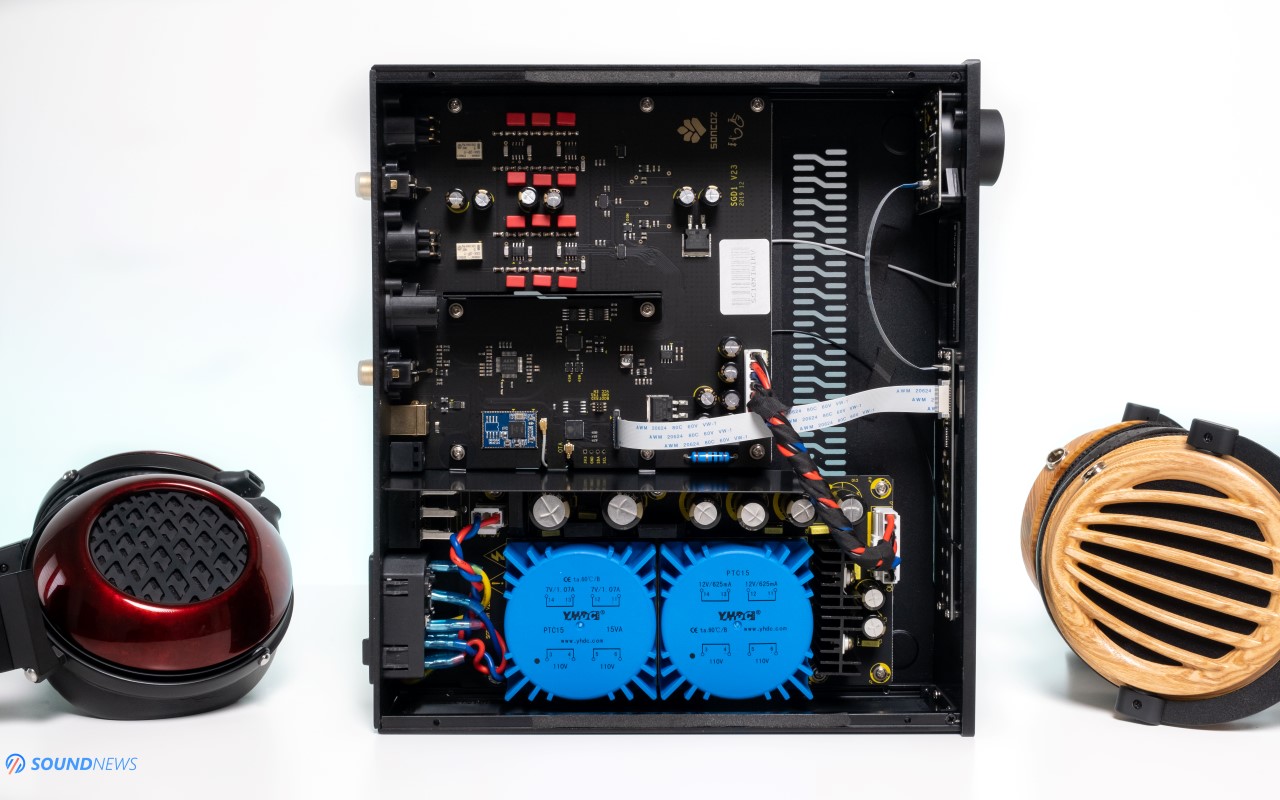
Tech Inside SGD1
The makers of Khadas Tone board and of Soncoz LA-QXD1 DAC had a ton of experience with the famous ESS 9038Q2M DAC chip of ESS Technologies. Instead of a single chipset, they put two units, completely separating the left and the right signal path, for a better channel crosstalk and of course to achieve a better signal-to-noise ratio. After installing its custom Thesycon drivers, it was clear to me that they used a stable XMOS interface and since it doesn’t support MQA files, XU-216 was out of the question. XU-208 was installed instead, that can be seen in most current generation high-performance USB DACs.
One of the coolest design decisions, was completely splitting the power supply for its analog and digital section, so that each part would be using a dedicated, low-noise, linear and regulated toroidal transformer. So far, only a single manufacturer from Asia had the same approach and that was Gustard Audio with their A22 DAC. There is a decent number of electrolytic capacitors for power filtering and storing, together with two transformers and three ultra-low-noise voltage regulators, SGD1 achieved one of the lowest noise-floors I ever experienced in digital audio – only 1.3 micro-Volts! Putting two DAC chips instead of one also lowered the channel crosstalk to a super impressive -143 dB, I’m already expecting a huge soundstage especially in a headphone setup where crosstalk is extremely important.
The input buffer-stage and the output stage are based on four op-amps: two RT6863S at the input stage and two musical sounding OPA1612A at the output stage.
Soncoz put the best Bluetooth receiver in this one, the mighty CSR8675 from Qualcomm, it supports Bluetooth 5.0 and all the major audio codecs as AAC, SBC, AptX, AptX-HD. For now, it doesn’t support LDAC, I’m not sure why, my smartphone can’t see it as an LDAC capable receiver, maybe a future firmware update will solve this issue.
What is kind of interesting is that they added a 2.4Ghz Wi-Fi receiver on-board that will be used only for software updates Over-The-Air (OTA for short). Check the user manual on how to do that, it is really simple. All in all, we are talking about a really nice DAC design that should be taken very seriously.
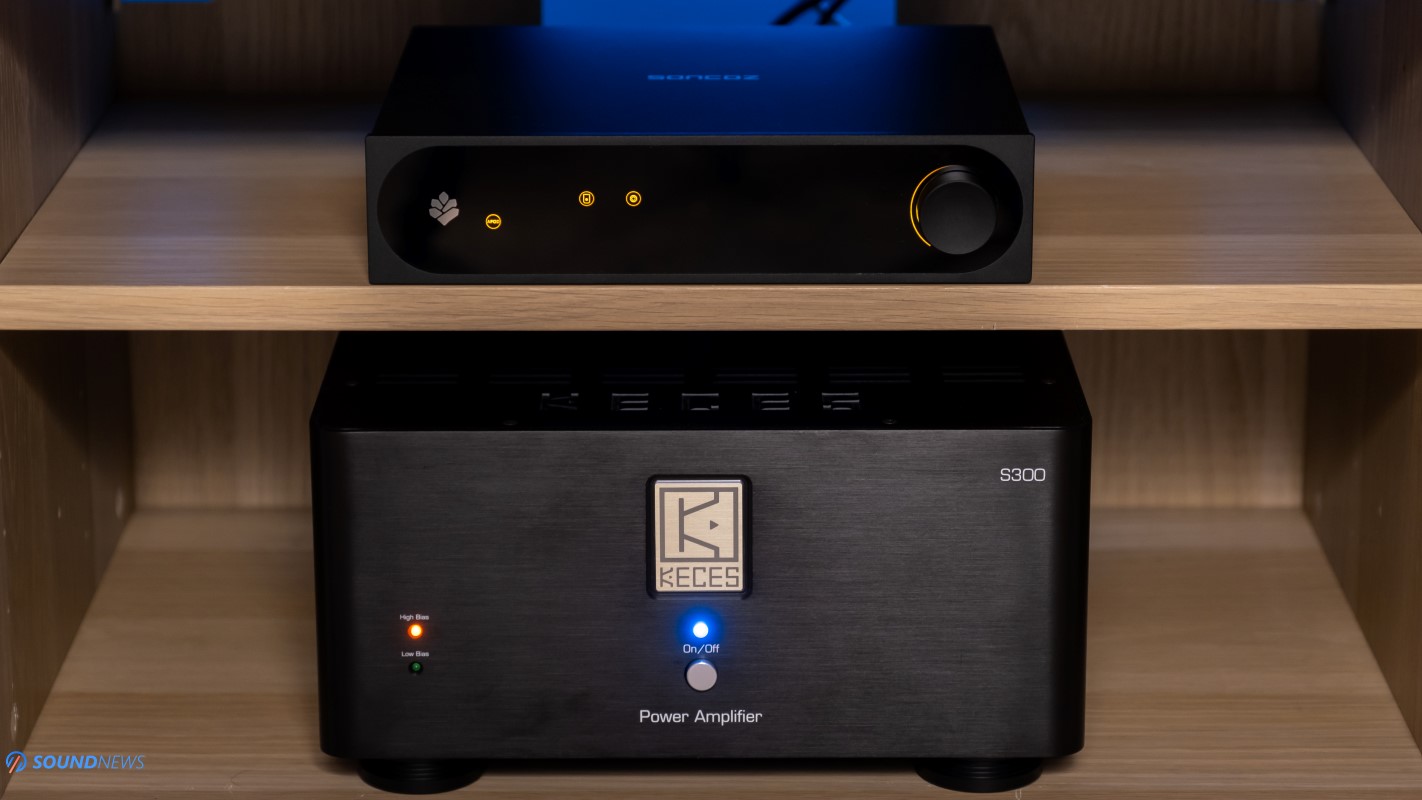
Test Equipment
I used it more in a headphone setup, where it was driving either a Benchmark HPA4 or a Flux Labs Acoustics FCN-10, followed by four planar-magnetic headphones: Hifiman Susvara, Audeze LCD-4, Kennerton Wodan and Erzetich Phobos – simply because my headphone setup is considerably more transparent and detailed sounding compared to my speaker setup.
In a loudspeaker setup it worked as a DAC + Preamp combo, powering directly a KECES S300 or a Kinki Studio EX-M7 power amplifier that was driving a pair of Buchardt S400 loudspeakers. Later on, I added a Benchmark HPA4 in the chain working a Preamp and moved the SGD1 working in its pure DAC mode – just to test its preamp capabilities. Enough with the talk, my ears are itching for some music, so let’s hit some ear-drums!
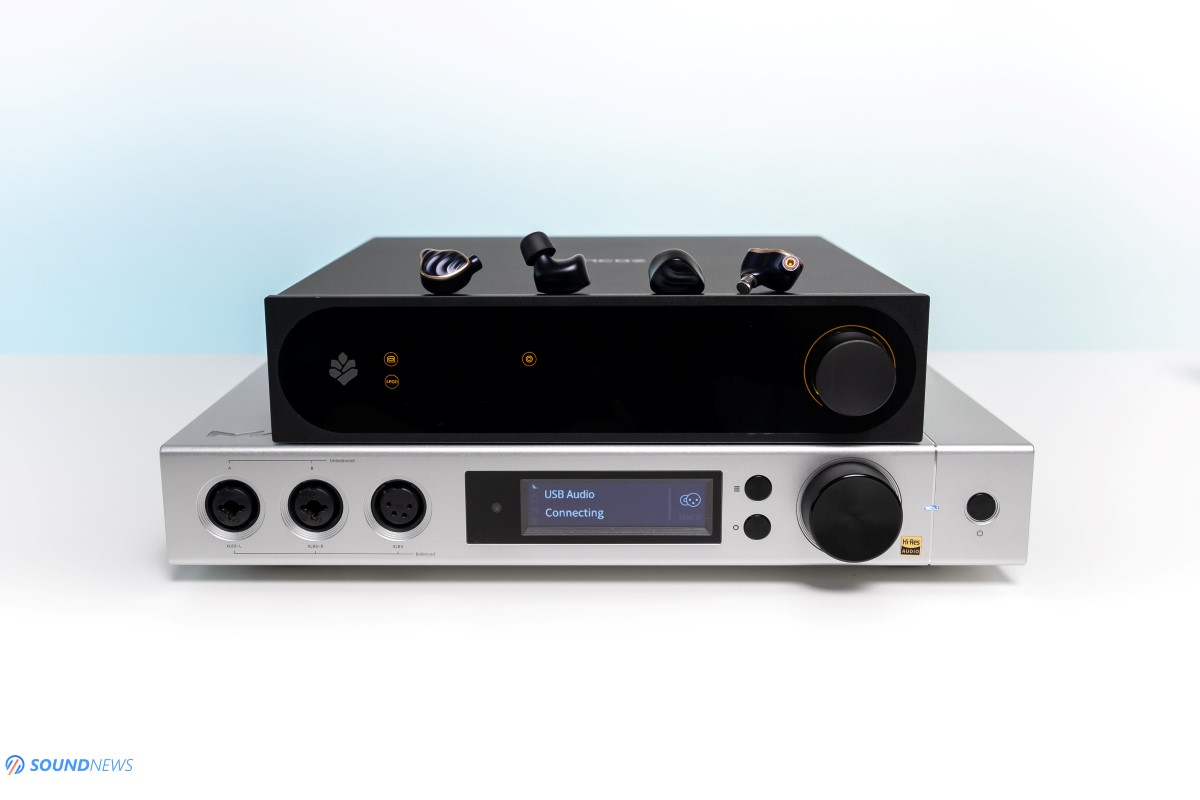
Sound Performance
I. Preliminary Impressions
Before I go really deep into the rabbit hole, I just want to mention that after seeing lots of capacitors inside and two linear transformers, it was simply mandatory doing at least one week of burn-in to unleash its fullest potential. A friend of mine visited me and since I was still working on my Aune S8 review, he volunteered to listed to it for a few days, which helped me immensely. After receiving it, I put 3 additional days on it – listening to it non-stop with headphones and speakers. It just passed a little over one week of burn-in and I’m ready to give my full impressions.
In the last three days I also compared it with an Aune S8 and also with my own Matrix Audio Element X, which was a huge eye opener for me. Those comparisons were made mostly with Hifiman Susvara, which are pretty much the definition of detail retrieval, of ultimate transparency and linearity, nothing can get passed their gaze and I’m yet to hear a more detailed transducer in a headphone or speaker form. With Benchmark HPA4, I can control the signal intensity on all its analog inputs, so I have volume matched all three DACs with the help of MiniDSP EARS and then I started some critical listening.
Before I tell you exactly how it sounds, I want to tell you first why I keep going back to listening to the Matrix Audio Element X. Its headphone amp section is Okay but far from great, I’m not using it at all, its internal streamer is very good, but its streaming app sometimes glitches or worse – crashes on me, it still needs some work to be perfect. However, it’s USB DAC part sounds unlike most ESS-Sabre DACs. It is extremely detailed and transparent sounding, or should I say the most transparent I’ve tried so far, but it is also a very punchy sounding unit, it slams like Thor’s hammer with some particular tracks. Its bass quantity and quality needs to be heard to be believed. Its midrange presence is close to an R2R DAC and don’t get me started with its layering and instant decays in fast executed tracks. It is far from thin or bright sounding ESS-Sabre DACs (I’m looking at you Mytek Brooklyn DAC+ and Benchmark DAC3, you nasty little buggers) and it is also far from flabby, slow or muddy sounding DACs. It has the right dose of technicalities and emotions. Its neither too wet, not too clinical, just perfectly balanced like Ying and Yang.
After engaging SGD1, I have spotted absolutely the same punchy bass performance that I am so in love with my Element X, midrange presence was also intact, voices sounded smooth and guttural, guitars and violins were weeping and touching my soul, there was that special ingredient that very little Delta-Sigma (D/S) are having. It simply knew how to create music and awake emotions, it knew how to envelop me with its musical wizardry, how to impress a music lover first and then a DAC addict later on.
Sure, it didn’t offer the last drop of resolution, the busiest passages didn’t sound as airy and layered, but the soul of the music was still intact, voices were still haunting me and it was able to create real emotions from zeroes and ones. I immensely enjoyed listening to this one, truly. It easily sounded as a kilo-buck digital source and I couldn’t believe than I was listening to a unit that costs less than half a grand. A few years ago, for a performance and build quality like this one is having, I needed to shelve some very serious cash.
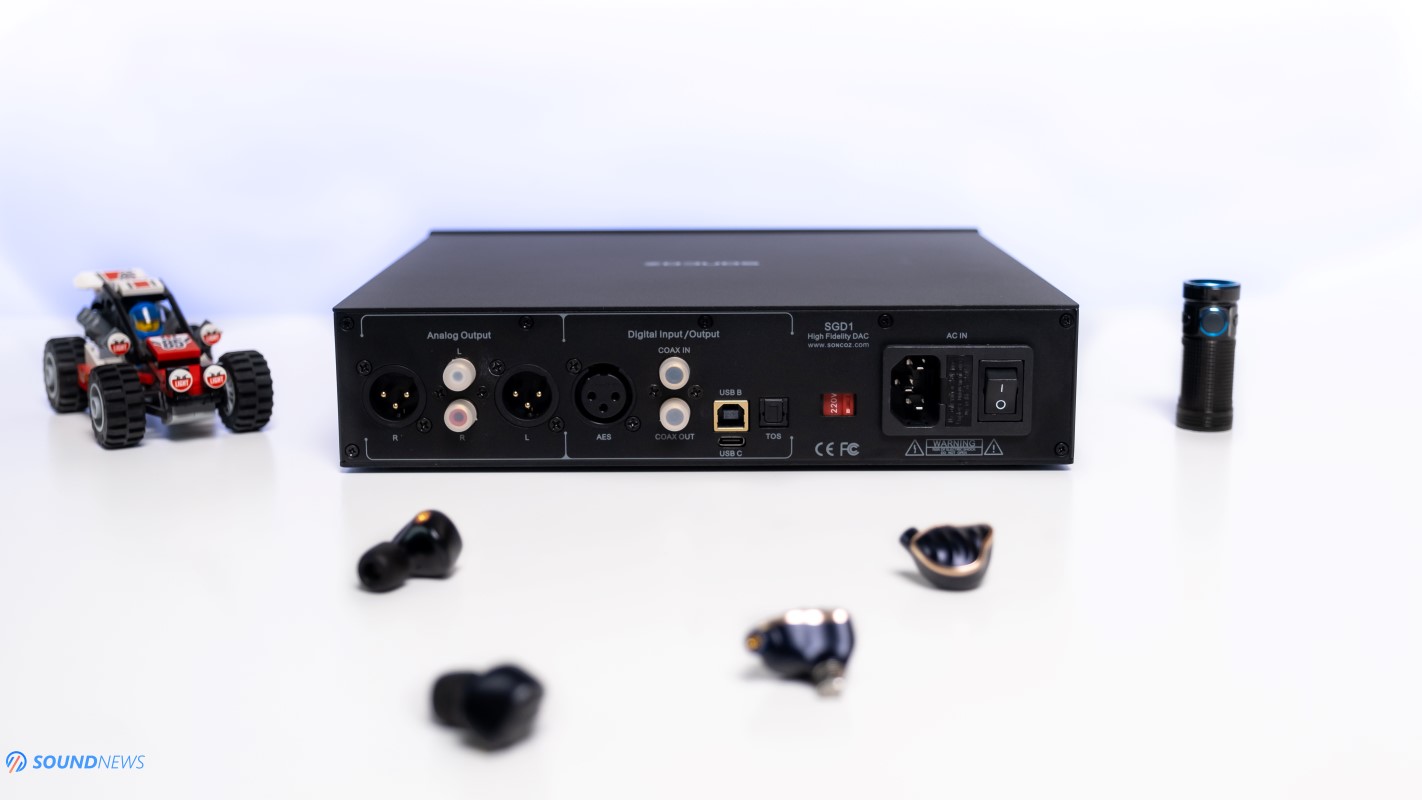
II. Noise Floor & IEM Compatibility
Imagine that Aune S8 – that I have reviewed last week had an incredible low noise floor of just 2.5 micro-Volts. I personally don’t have such equipment that can show me that noise, I consider that my amplifiers, digital sources, transducers and ears can capture a dirty background, distortion or some gremlins in my music. As much as I’ve tried with sensitive IEMs as FiiO FA9 and Meze RAI Penta, I simply couldn’t spot any hissing or humming with it, I’ve heard only a haunting dead-silence all over my music.
Soncoz went overkill with two transformers and multiple voltage regulators and all that lowered its noise much further to an inaudible 1.3 micro-Volts of noise! Connecting it to the Benchmark HPA4, I went full power up to unity gain and still, I couldn’t hear a disturbing noise or even a trace of it. In this regard, SGD1 performed exactly like the Matrix Element X which costs more than 6 times.
I also started evaluating the flagship power amplifier of KECES, called S300 and I thought that should try it with SGD1 in a speaker setup. In this rig, SGD1 worked as a DAC + preamp combo and I was using its remote for convenience. SGD1 doesn’t have a true line-amplifier inside, so that combo sounded just by a hair duller compared to a Burson Conductor 3X Performance or to a Gustard A22, but the background felt again super clean and noiseless. I went almost full-power, I have paused my music and approached closer to the S400 loudspeakers and there it was: the loud sound of silence. SGD1 is a dead-silent DAC and it didn’t matter if I was using it with headphones or speakers, the final result remained the same. In the end, I’ve heard a crystal-clear sound with a dark as night background and there is nothing more to say about its noise floor, as it simply doesn’t exist.
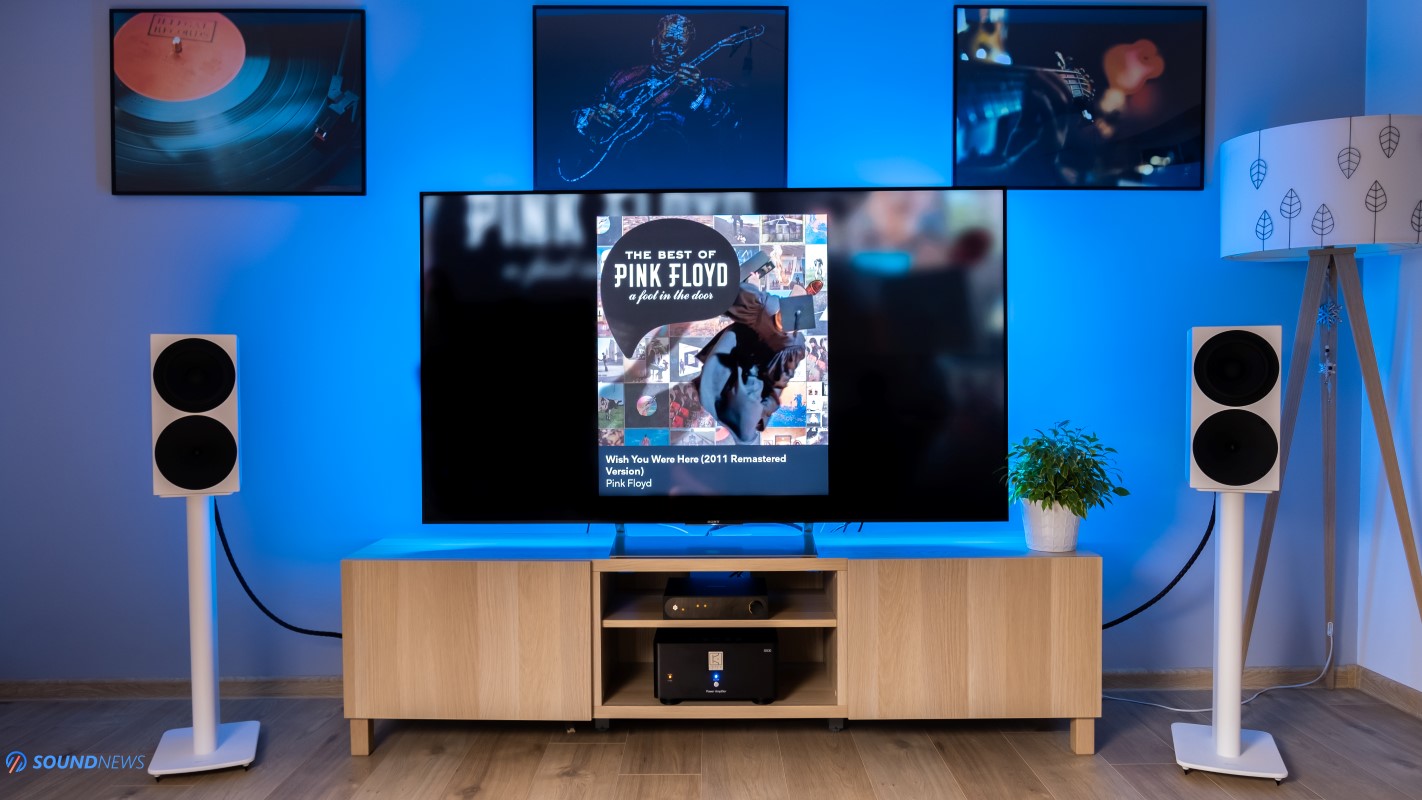
III. Transient Response
- The Prodigy – Diesel Power (Tidal / Spotify) shoving those bass notes inside my brain? Check!
- Marilyn Manson – Killing Strangers (Tidal / Spotify) hits like Thor’s hammer? So addictive!
- Heavy headbanging on Rage Against The Machine – Killing In The Name (Tidal / Spotify)? Toe taps and air drumming too!
- Lightning fast bass execution of Infected Mushroom – Spitfire (Tidal / Spotify)? I wish all DACs would hit with so much authority and slam as SGD1 is doing.
I am pretty sure we have a new winner in terms of transient response in the sub one grand DAC category. It actually sounds very alike with my Element X in here – I love it mostly for its faster pace and for delivering more bass layers and air in the lowest octaves. It isn’t a secret to anyone that the hardest frequency range to render perfectly is the low-end, it is the only frequency range that could shut down your speaker amplifier when it can’t handle it. I have a tremendous respect for DACs that can properly deliver a bass note exactly how I want it, carrying a right amount of quantity and also being clean, defined and weighty. Those two linear transformers left their last words exactly in here. Without them, I wouldn’t be experiencing this tremendous bass slam and impact and I’m glad than Soncoz went overkill with the power supply. For the love of music, Soncoz, please use this philosophy as fuel for all your future flagship devices. Thank you!
Even relaxed songs as Way Down Deep by Jennifer Warnes (Tidal / Spotify) are sounding much fuller, denser, heavier and punchier. It is like looking at a photo with a vivid filter applied to it. I want to be clear that a well-designed DAC should sound like this, yet very few are performing at this level. There are many units past $1000 mark that don’t possess a well-balanced tonality and will be delivering punchy dynamics more like a feather than like a kangaroo. Yesterday another friend of mine visited me and he took a listen to the SGD1 and compared it to his own KECES S3 DAC. We both agreed that SGD1 was simply a better unit. Low-end was more contoured, midrange felt more natural sounding and treble felt extended yet relaxed and easy on the ear. We both observed that its kick and slam in the chest was something entirely different and I’m glad we experienced all this in a very affordable unit.
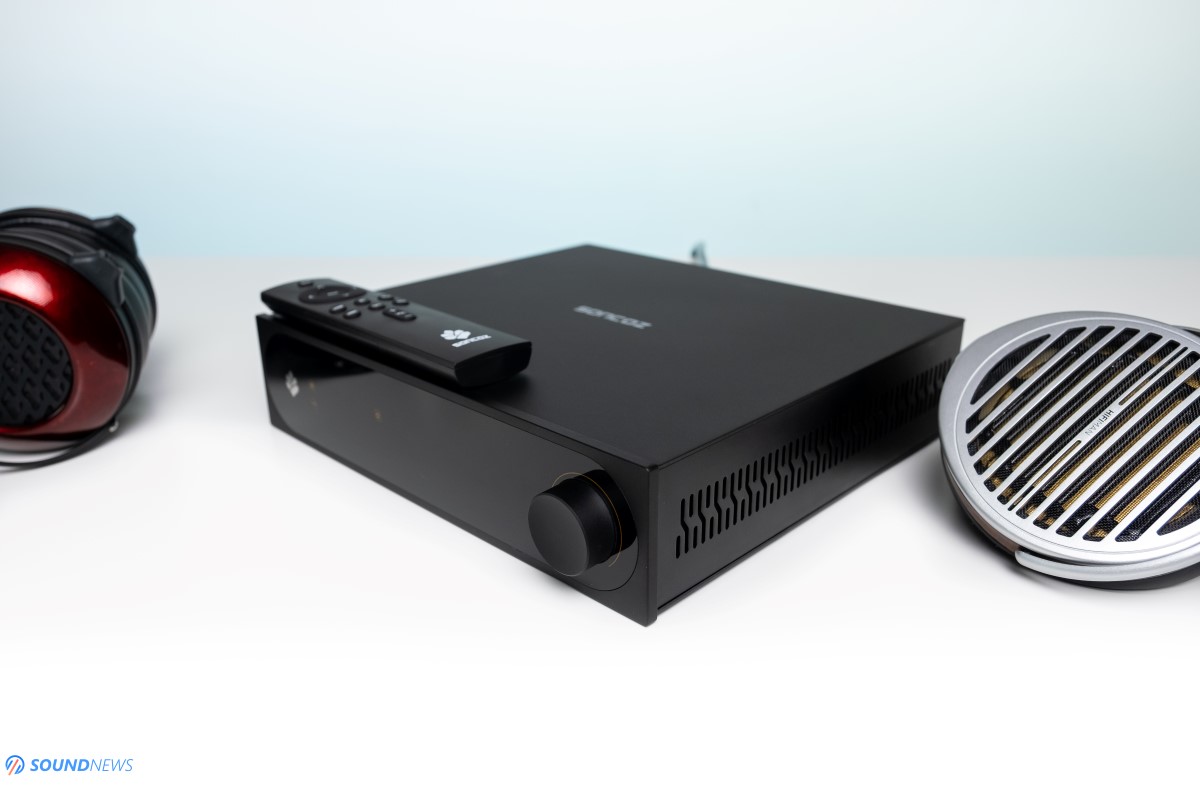
IV. Resolution & Transparency
I’m still writing about an ESS-Sabre DAC, isn’t it? SGD1 actually uses two chips for the last drop of dynamic range and also to further decrease its distortion and channel crosstalk. Even from its first day of use, SGD1 presented itself as a clean sounding unit that really cared about resolution, transparency and dynamics. Do note that Soncoz put the mobile version 9038Q2M inside, yet it sounds so amazingly close to the PRO version inside the Matrix Element X. I have a strong feeling that they squeezed the absolute last drop of performance out of this chipset. I can certainly say that SGD1 sounds more detailed than a Burson Conductor 3X Performance ($1399) and about on the same level with kilo-buck ESS-Sabre DACs.
One of the nicest test tracks to test the dynamic range and microdetail of a digital source is Fleetwood Mac – Go Insane (Tidal / Spotify). Even from the first seconds, a cold chill went through my spine, those guitar plucks touched something inside. The plucks felt real, visceral and full of live. I felt everything well spread around me, there was a big void space between every note, between every inhale and exhale. Lindsay voice was simply oiling the overall performance so it would go smoother with a glass of bourbon. I have nothing to reproach, nothing. It sounded exactly as it needs to be: it moved me, it created emotions, it was surreal, it decompressed that song, that I felt the urge to lean back and finish it without doing anything else.
Agnes Obel – The Curse (Tidal / Spotify) is a clean sounding track with a long decaying voice, the contrabass sounds extremely weighty with the right source and amplifier, which I wasn’t surprised to hear at all. Agnes voice was somehow everywhere in this track, even in front and behind violins and piano, weird at first but extremely soothing and relaxing. Although sounding defined and natural, piano and violins were paling in comparison with her voice.
All in all, SGD1 performed exactly how I would define a clean, detailed and transparent sounding unit. It had all the traits of modern digital to analog converters and if you are looking for micro-details and imperfections in your music, you can hear that without closing an eye.

V. Soundstage & Depth
Generally speaking, from D/S DACs, ESS-Sabre ones are those that are sounding closer to the listener, creating a cozy, but up-front sound. Benchmark DAC3 and Mytek Brooklyn DAC+ sounded exactly like that, with a very narrow soundstage and with little to no depth at all. Tinker with their power supplies and filtering and somehow exactly the same ESS-Sabre DACs are starting playing in much bigger rooms, with more air moving around and while sounding much deeper too. Soundstage can be unleashed even with ESS-Sabre DACs, if you know how to do that. There is a reason why both DACs that I mentioned above are being modified with linear transformers even nowadays. SGD1 is an airy sounding unit and that was felt from the first seconds of pressing play. Even crowded music as electronica, rock or metal sounded decompressed and untangled, there was more happening on my left and right and I’ve felt my music playing on multiple layers, with some notes closer to me, other farther away, some to my right, some behind me, creating a distinct 3D map of every track.
An outstanding example is Jump – Van Halen (Remastered) (Tidal / Spotify) – it sounded raw, explosive and hard hitting, so fricking engaging and yet there was so much air traveling around Eddie’s guitar, around those drums, synthesizer, the vibration of those cords echoed around the room really nicely. It sounded more like a well recorded live-album than like a studio record. Dynamic range was outstanding and positioning of all those instruments in the room was very precise. I could easily pin point their location and all that sounded defined, clear and so alive. I wish the same could be said about our friend Eddie, Rest In Peace pal!
If soundstage is what are you chasing for, SGD1 sounded very much like a Topping D90/D90 MQA/ Gustard A22 and it is really one of the best options if you want to increase depth and stage size in a very natural way.
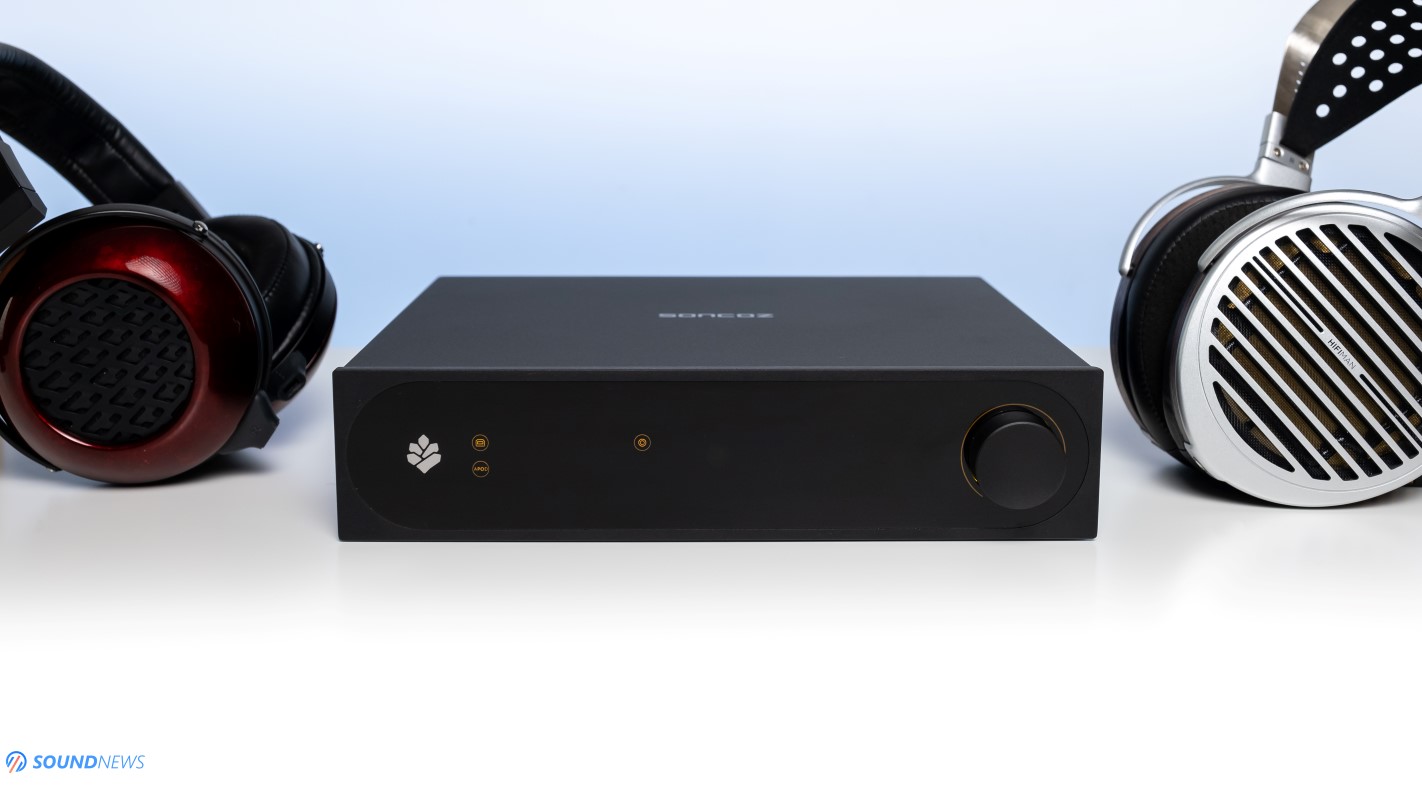
VI. Frequency Response
This is a very interesting part, SGD1 felt as having an extended frequency response, from the lowest octaves to the highest trebles, everything was rendered clear and super defined. With all that said, few things stood out from the rest. First was of course that full-bodied, deep reaching and hard-hitting bass performance. Even two friends of mine, observed that its bass performance stood out immediately. It will be uncovering bass notes in the most unusual places like folk music or classical music. Anywhere I would hear a double-bass, my mind would immediately focus of that imposing slow moving air mass. Bass felt thumping hard and I really enjoyed listening to a lot of rock and electronica with it. Starting with yesterday, Van Halen was all over my playlist and of course all that sounded ballsy and very bold, raw and energetic. No matter if I am listening to some bass intensive music or not, SGD1 would always find those notes and highlight them to the listener, I find that interesting and entertaining.
Midrange was the second-best thing that stood out immensely. SGD1 always sounded effortless, smooth and natural, unlike most D/S DACs. It was spot on, with sweet harmonics and natural decays of the notes. It’s hard to explain, but it just sounded right from the moment I pressed play. I’ve experienced harsh, cramped and dry sounding sources, but this one was completely different. I’m very much into mid-centric music and I’m against V-Shaped sound signatures. Midrange is still the most important frequency range, because the soul of the music lies exactly in here. Without it, acoustic music would sound empty and emotionless, voices less guttural and weighty. SGD1 tilted towards well-made R2R DACs, it resonated with then, it has that silk thread that is binding all the notes together creating real music and not a fake rendition of it.
Treble is there in right doses, it is as clean and defined as the rest of the FR, but it never jumps ahead of that low-end and midrange. It is extended even past upper treble, but it never asks for a full attention of the listener. I don’t find it bright, there isn’t any ringing in here, on the contrary it is smoother and more relaxed. I can listen to treble-intensive music all day long with SGD1 on my table. I actually did that, as I was full-on Van Halen for the last two days, still can’t believe we lost such a down to Earth person. Cymbals still sounded metallic and extra crispy, tambourines were snappy and engaging, snare drums had a good impact. It had everything I want from my treble, except for nasty ringing and harshness which I can’t stand for more than few minutes.
All in all, Soncoz SGD1 had an amazing tonal balance, more on the fuller side in the bass and midrange and slightly more relaxed and easier going in the treble – which made pairing with neutral sounding amplifiers, speakers and headphones, a much easier task. I still can’t forget how authoritative it was sounding in the bass and its ability to portray a bigger and a wider soundscape.
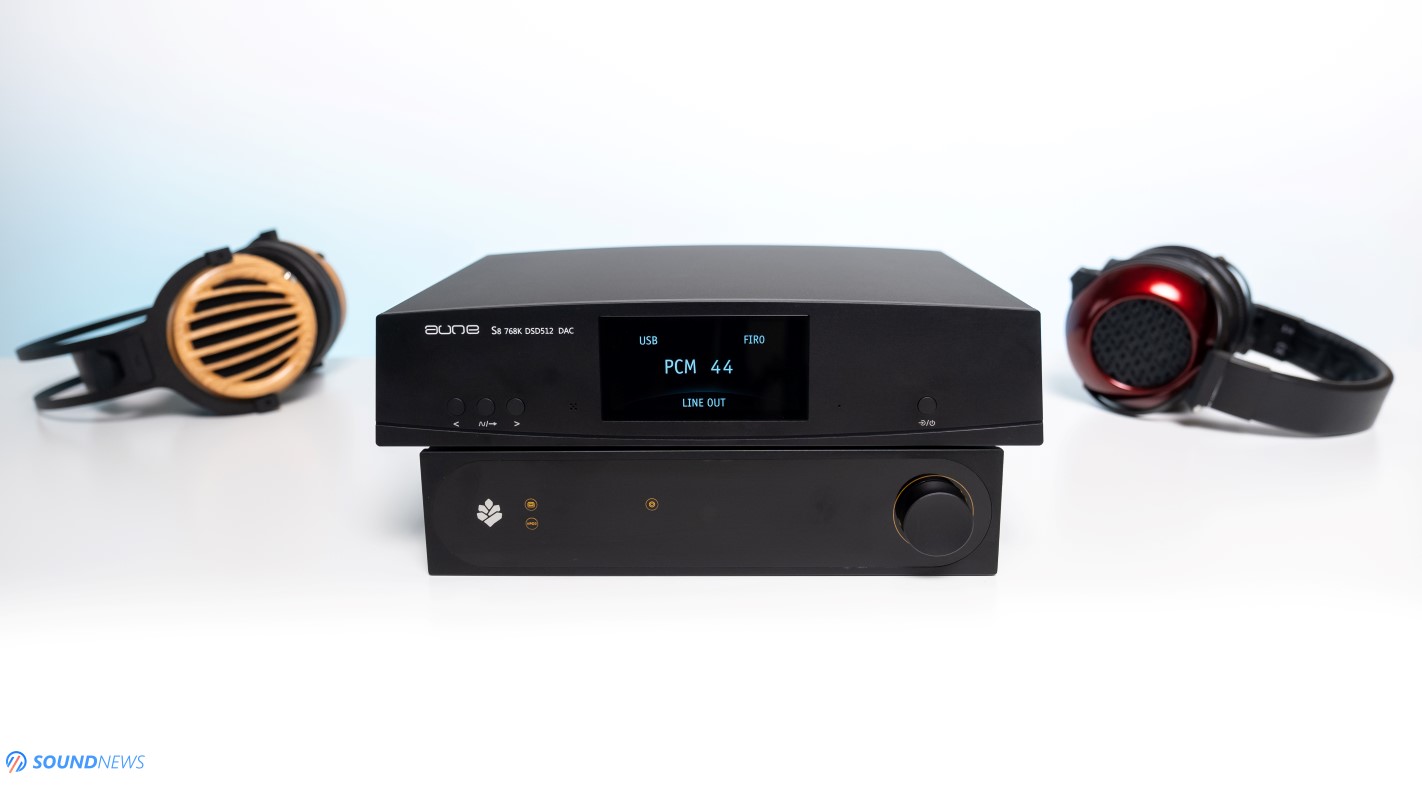
VII. Comparisons
Soncoz SGD1 ($459) VS Aune S8 ($998)
In terms of features, S8 has an LCD screen in the middle, where you can see your exact volume level and some additional info, it also has an additional digital input. Both can be used as pure DACs or as DAC + Preamp combos. Aune went with a single ESS 9038 PRO DAC chip and Soncoz with two but slightly lower grade ESS 9038Q2M DAC chips. Aune has a custom femto-second master clock, by comparison Soncoz used some off-the-shelf clocks which were not specified in its user manual or webpage. SGD1 has two additional functionalities though: it can work as Bluetooth receiver and as a digital to coaxial converter.
They both look beautiful and well built, but I personally enjoy the CNC roll-cage of S8 a little bit more, it just looks more elegant and premium to me, as it is built from a single piece of aluminum. S8 is using a single linear transformer and a big number of capacitors for filtering and power storing so we are definitely talking about good power supply implementations in both units.
In a speaker setup they worked as DAC + Preamp combos, directly driving a KECES S300 or a Kinki Studio EX-M7 power amplifier. Both units don’t have actually line-amplifiers inside, but most likely a digital attenuator that is lowering their signal strength. Both sounded lighter weight, not as defined and controlled as a dedicated line amplifier would sound. I wanted more impact and body hits and more raw energy out of them. When I have added a Benchmark HPA4 in the chain working as a dedicated preamp, things improved considerably and I can now differentiate them pretty easily.
Aune S8 felt more linear sounding, it was always serious, nothing really stood out, its frequency response was extended and straight as a line. It always sounded clean, transparent with just a very small dose of naturalness. Midrange was very detailed, with a strong contour, guitar plucks sounded real, their vibrations felt defined and outlined. Cymbals sounded extra crispy, sometimes it could be too much in a super revealing rig. SGD1 immediately felt slightly punchier sounding, its low end was standing out, hitting my eardrums with a stronger brute force. SGD1 was by a hair more engaging as it moved more air down low and put a bigger importance to its midrange presence. You can call SGD1 as a slightly warmer sounding unit, it sounded closer to FPGA and R2R DACs as it carried a meatier tone and a bolder overall presentation. If S8 wanted to disappear from the acoustic chain and let the true nature of the amplifiers and speakers be heard, SGD1 was adding a bit of its own flavor, injecting more bass and midrange presence at the expense of lesser detail up top. Depending on taste, one might outperform the other, but I’ve felt them being in the same boat, having just different personalities.
In my headphone setup, I have experienced the same with the exception that everything was intensified and S8 came out as clearer sounding and SGD1 as more saturated. Depth and soundstage were decompressed on both units and they both can be considered as soundstage kings. I consider S8 a slightly higher tiered device. Nonetheless, I immensely enjoyed my time with SGD1, as it had its own personality, which reminded a lot of my own DAC.
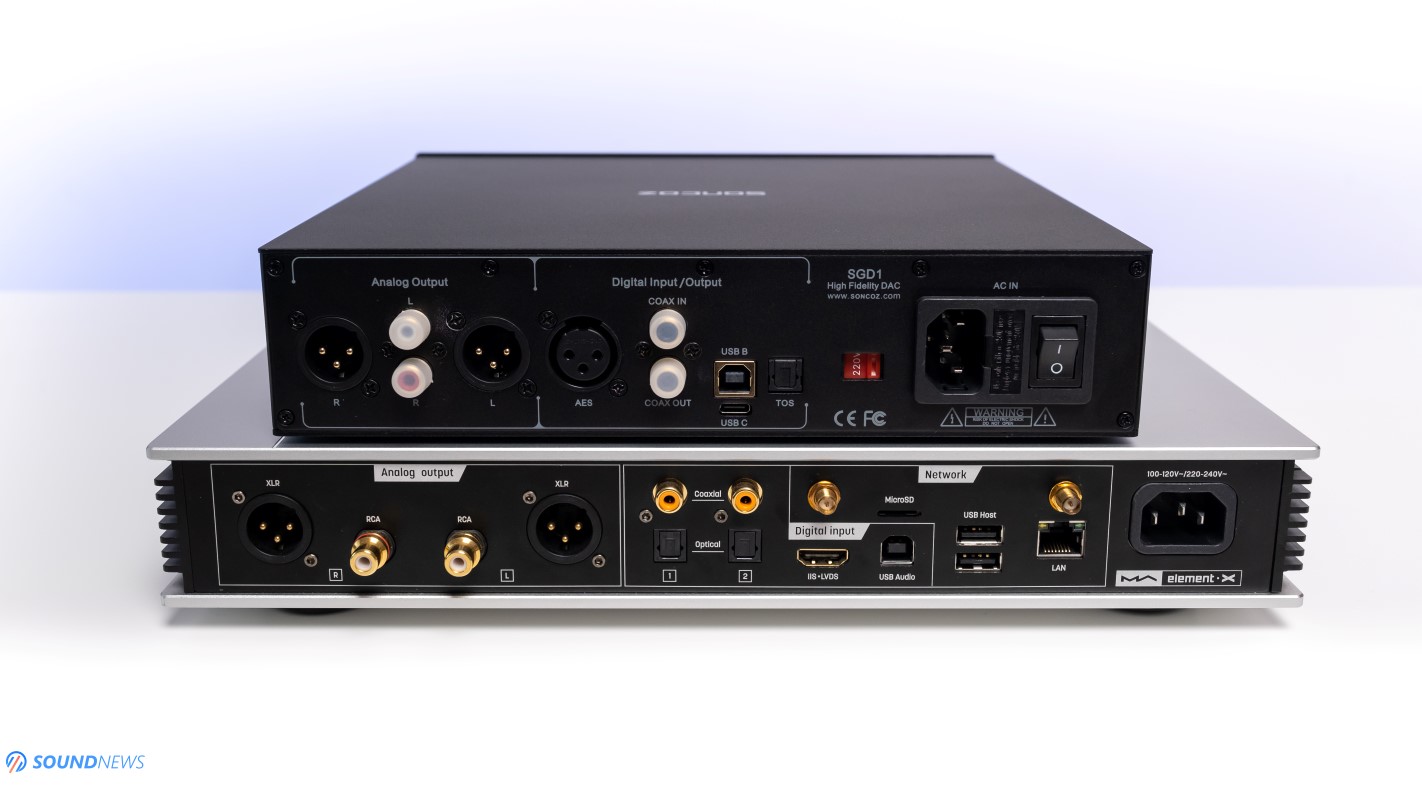
Soncoz SGD1 ($459) VS Matrix Audio Element X ($2999)
In terms of features, Element X is considerably more advanced with a fully working streamer, a standalone music player by using external storage, a balanced headphone amplifier and it also has a stepped hybrid volume control that works great in a speaker setup. It has a full MQA decoder and its LCD screen will show a lot of important info. It has more digital inputs and a hotter analog output of 4.5V over XLR which I personally like with my preamp.
In a speaker-based setup, Element X stood out immediately with its better volume control, air was moving easier around the room, an extra layer of information was unleashed and the depth become holographic as I could better appreciate the distance between all musical instruments and my listening spot – a thing that wasn’t as clear and precise on SGD1.
Soundstage was by a hair more expanded with Element X, it pushed those notes farther away, as If I had a bigger pair of speakers in front of me. SGD1 was coming close with its airy and weighty low-end presentation, but still Element X felt airier, more expanded and more controlled. If I’m adding a dedicated preamp in the chain as Benchmark HPA4, then the gap shrinks and SGD1 is coming pretty close performance wise. Still, there is by a hair more resolution and dynamics on Element X, it sounded deeper and more extended left to right.
When I’m moving both to a headphone setup, where most of this comparison was done and after carefully volume matching using a MiniDSP EARS and calibrating all that with the Benchmark HPA4, it was clear that both devices are sharing pretty much the same character, like both were made in the same factory. Both were slamming really hard in the bass, having a faster pace and a short decay, both presented a fuller midrange where musical instruments felt real, palpable and very outlined. Treble rendition was more or less the same, but Element X felt having clearer cymbals and tambourines in some tracks. Detail retrieval was very high with both, still the more expensive unit shown an additional layer of info, it was brutally honest sounding. I like to hear everything that is hidden in my tunes and Element X was better at highlighting all those microdetails, SGD1 was close but wasn’t as clear and defined. Soundstage size via headphones was much harder to discern, since we are talking about drivers siting 2cm away from my eardrums. Only with live and well recorded music, I could appreciate more air around those notes with Element X. For example, while listening to Way Down Deep by Jennifer Warnes (Tidal / Spotify) and Hotel California (Remastered) by Eagles (Tidal / Spotify), Element X was pushing more air in my room, the walls felt distant as if it was recorded in an open space. Both sounded extremely close to each other, they had the same traits and I just realized how much digital audio moved forward in the last few years. It is really impressive how effortless, ballsy, textured and real a DAC can sound that costs so little.
As a DAC only device, you need to have a serious setup to differentiate both units, even with what I have in front of me, it was quite a challenge and without the Susvara and Audeze LCD-4, I would have a much harder task to finish. I can easily call the SGD1 as a mini-Element X, because it really performed as one.
I can’t stop wondering how a higher tiered Soncoz device with two Noratel transformers, with a bipolar buffer stage, a J-fet output stage and some top-of-the-line Crystek CCHD-950 femtosecond clocks in the same chassis would sound. Ben, are you up to the challenge?

Conclusion
Soncoz has a lot of experience under their belts with that ES9038Q2M chipset and the more I’ve listened to SGD1, the more I’ve realized that they were able to squeeze the absolute best this chipset has to offer. Its dead-silent noise-floor needs to be heard to be believed, as with or without an expensive passive power conditioner, SGD1 was mute with sensitive IEMs. It worked like charm with those, even heavy power amplifiers didn’t bring any noise floor into the chain. I cannot stop from wondering what they could achieve if size or budget would not be a limiting factor. I only wish it had a true line amplifier inside and I hope so see Bluetooth updated soon with LDAC codec support.
I’ve had a longer conversation with a friend which has a DAC three times more expensive than this one and he preferred the SGD1 in his setup. We both agreed that as DAC only device, it can easily compete in the ~$1000 DAC category anytime of the day. It was very unusual seeing two linear transformers for the analog and digital circuitry, especially at this price point. Those transformers are not cheap and the same can be said about two flagship ESS Sabre chips, audio-grade capacitors, voltage regulators and crystal clocks. I simply don’t understand how Soncoz was able to price it so aggressively low?
As a DAC only device, it plays in the big league, it simply performed above my expectations and in a less revealing system, I probably wouldn’t differentiate SGD1 from my own Element X. I really don’t have much to complaint about. I was so impressed by its performance and low price point that I am going to award it our highest Golden Award.

Congratulations to the team and I am looking forward to their next digital creatures! I don’t consider it a mid-fi sounding unit at all, but a serious one that can compete with the best there is. I wholeheartedly recommend it!
Soncoz SGD1 was kindly provided by HiFiGo, it will cost you $459 and you can get it from their web-store by following this link.
PROS:
- Simple, yet elegant looking device
- Great build quality
- Warmer tonality, leaning towards naturalness
- Great resolution and transparency
- Very good pin-point location of all the notes around the listener
- Amazing soundstage and depth
- Excellent dynamics, kick and punch
- Noiseless even with ultra-sensitive loads
- Rich and full-bodied all the time
- Wide selection of digital inputs and analog outputs
- Very extended in the frequency response
- A feature-packed 4-in-1 device
- One of the best values
CONS:
- Some taller feet would be nice
- No LDAC codec support via Bluetooth
- Its preamp section could be better
ASSOCIATED EQUIPMENT:
- Sources: Xiaomi Mi 9T Pro, Corsair One i160
- DACs: Soncoz SGD1, Aune Audio S8, Burson Conductor 3X Performance, Audiobyte HydraVox + HydraZap, Matrix Audio Element X, Flux Lab Acoustics FCN-10
- DAPs: Shanling M6, FiiO M15
- Headphone Amps: Benchmark HPA4, SparkoS Labs Aries, Flux Lab Acoustics FCN-10, LittleDot MKIII SE
- Integrated Amps: KECES E40
- Power Amps: KECES S300, S125, Kinki Studio EX-M7
- IEMs: FiiO FA9, FH7, Meze Rai Penta, Rai Solo & lots of other lower tiered ones
- Portable headphones: Sennheiser Momentum 2, Meze 99 Classics
- Wireless headphones: Sony WF-1000XM3, Sennheiser Momentum 3, Master&Dynamic MW65
- Full-sized headphones: Hifiman Susvara, Hifiman Arya, Audeze LCD-4, Erzetich Phobos, Erzetich Mania, Quad ERA-1, Ollo S4X Reference, Kennerton Wodan, Magni & Gjallarhorn, Fostex TH909
- Loudspeakers: Buchardt S400
- Interconnects: QED Reference (x2), Aune AL3
- Speaker cables: Kimber PR8, Audioquest Type4
- Power Cables: Isotek EVO3 Premier (x3)
- Balanced Isolation Power Conditioners: PLiXiR Elite BAC400, KECES BP-600
